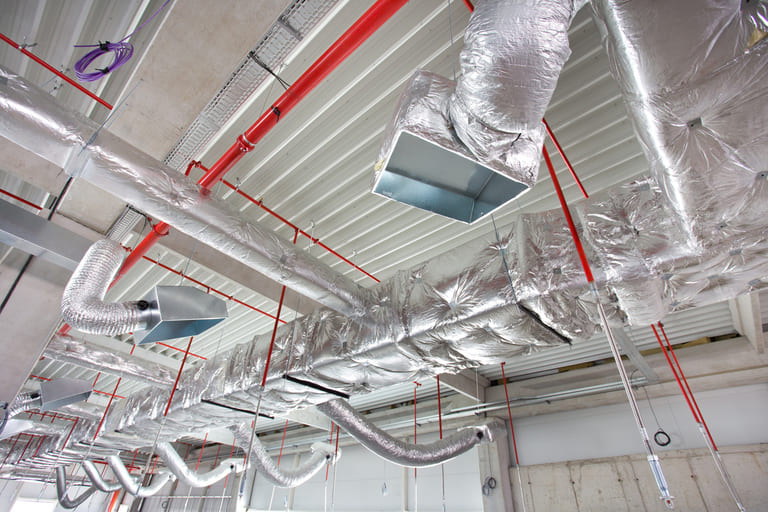

Taiyo Kogyo Column
Thorough explanation of firefighting equipment for tent warehouses|From necessary equipment (fire extinguishers) to inspections and fabrics.
2025.05.01
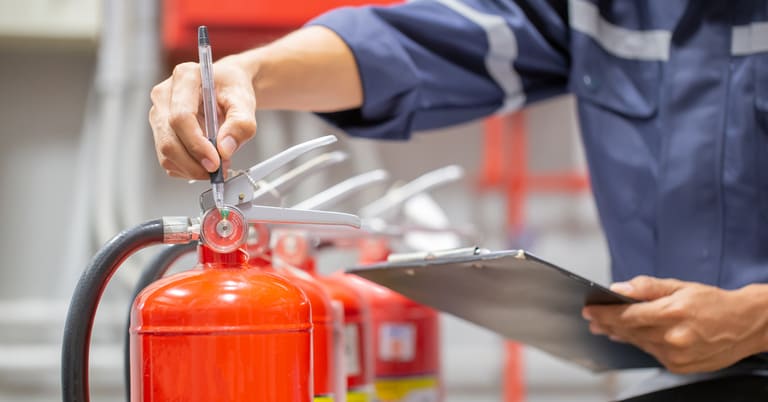
Tent warehouses are buildings completed by stretching sheets (tent fabric) over a framework, and can be constructed in a short period of time and at low cost.
However, as a type of building, it must comply with laws such as the Building Standard Law and the Fire Defense Law.
In particular, the Fire Service Law requires different firefighting equipment depending on the size and use of the tent warehouse, so it is essential to provide appropriate equipment.
This article provides a detailed explanation of the requirements for equipment required under the Fire Service Law, as well as information on tent fabrics, which are an important firefighting measure.
>> Click here to visit our website specializing in “Tent Warehouses”.
What is the Fire Service Law?
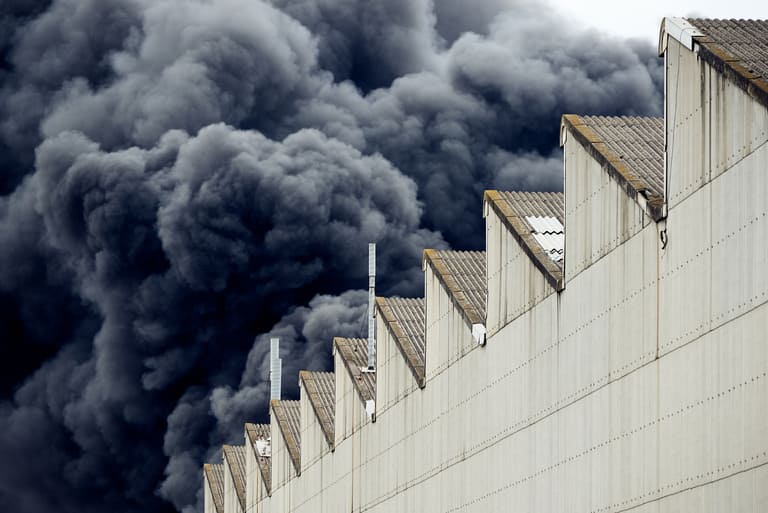
The Fire Service Law aims to prevent fires and minimize damage.
It stipulates fire prevention measures, equipment, training, and inspection requirements to protect human life and property.
The law applies to all buildings and violations may result in severe penalties.
Specifically, the law requires the appointment of a fire prevention manager and the preparation of a firefighting plan to prevent fires from occurring.
They are also required to conduct evacuation drills for employees and residents. This will ensure a quick response in the event of an actual fire.
In addition, buildings are required to have firefighting equipment. Sprinklers, fire extinguishers, and fire alarms must be installed and regularly inspected and maintained.
Failure to do so not only compromises safety, but can also result in fines of up to 100 million yen for the corporation.
It is also important to ensure evacuation routes. Emergency exit signs and pathways must be installed and secured to prevent confusion in the event of an emergency.
If a violation of the Fire Service Law results in increased damage from a fire, the company or its management may be subject to serious social liability.
This law has been amended in response to social conditions.
For example, fire prevention management was strengthened in response to a fire that broke out in Kabukicho, Shinjuku-ku, Tokyo in 2001. The law is being revised based on lessons learned from these past accidents.
What firefighting equipment is required by the Fire Service Law for tent warehouses?
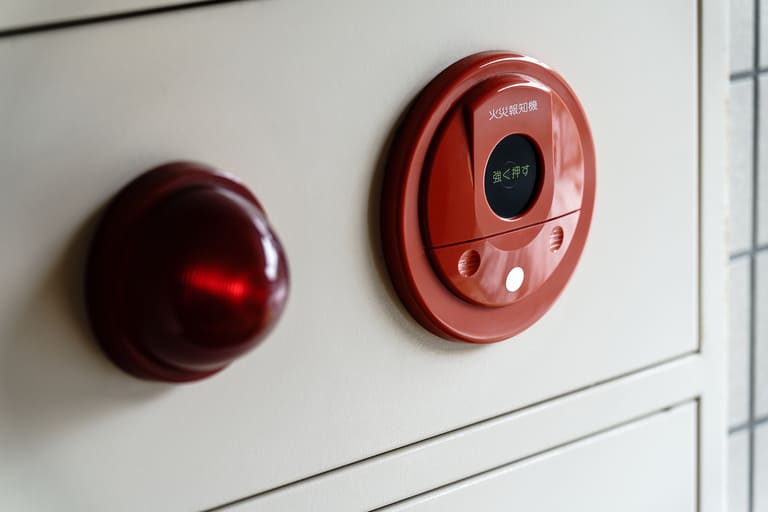
Installation of firefighting equipment in tent warehouses is required under the Fire Service Law.
This provision is intended for quick response in the event of a fire, and the required equipment varies according to the total floor area.
Specifically, fire extinguishers are required to be installed if the total floor area is less than 500 m2.
In addition to fire extinguishers, fire alarms are required for buildings between 500 m2 and 700 m2.
In addition, for buildings over 700 m2, an indoor fire hydrant must be installed in addition to fire extinguishers and fire alarms.
Since these regulations apply without exception even to warehouses storing nonflammable goods, it is important to install and maintain appropriate equipment.
The warehouse must meet the standards of the Fire Service Law and be operated in a safe manner.
Fire extinguishers required for tent warehouses in accordance with the Fire Service Law
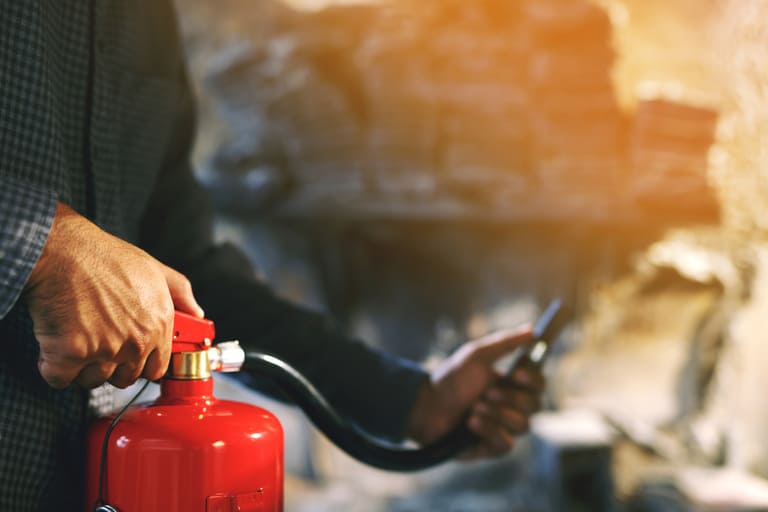
The installation of fire-fighting equipment in tent warehouses must be in accordance with the Fire Service Law.
In particular, there are clear regulations regarding the location and number of fire extinguishers.
Therefore, the standards for the size and use of tent warehouses must be confirmed in advance and properly arranged.
Number of fire extinguishers required
In accordance with the Fire Service Law, the indicator “capacity unit” is important for the proper installation of fire extinguishers in tent warehouses.
The capacity unit indicates the fire extinguishing capability of the extinguisher and depends on the type and size of extinguishing agent.
For example, the capacity unit for a Powder Type 3 extinguisher is 1 and that for a Powder Type 6 extinguisher is 2.
To determine the number of fire extinguishers required, calculations are based on the total area of the warehouse and the applicable area per unit.
The formula is “total area ÷ 1 unit/m² = capacity unit.
This 1 unit/m² standard depends on the structure of the building.
The standard is 200 m2 per unit for fireproof buildings and 100 m2 for non-fireproof buildings.
For example, if a fireproof tent warehouse has a total floor area of 1000 m2 , then “1000 m2 ÷ 200 m2 = 5” and the required capacity unit is 5.
To meet this capacity unit of 5, you can install either 5 powder 3 extinguishers or 3 powder 6 extinguishers with a capacity unit of 2 (6 units in total).
The total area of the warehouse and the structure of the building must be considered, and the required capacity units must be calculated before the appropriate type and number of fire extinguishers are placed.
Check the standards of the Fire Service Law and ensure that the placement meets the required capacity units.
Standards for Fire Extinguisher Installation
Standards for the installation of fire extinguishers in tent warehouses are detailed to ensure the safety of facilities subject to fire protection.
Installation standards require that fire extinguishers be provided on each floor and available within a walking distance of 20 meters in principle from any part of the building, and within 30 meters for larger facilities.
In addition, it is important to install the equipment in a location that does not hinder traffic or evacuation, and to be able to carry it immediately in the event of an emergency, so that it can be used promptly.
In addition, fire extinguishers must be mounted no more than 1.5 m above the floor and must be protected by containment in outdoor areas, kitchens, and areas where steam or gas is generated.
In addition, because of the high risk of fire in facilities where designated flammable materials are stored or where large amounts of fire are used, standards for the installation of fire extinguishers are also strictly enforced.
In particular, when handling designated combustibles such as cotton, wood, straw, etc., fire extinguishers must be installed 50 times the designated quantity, depending on the amount of those materials.
Furthermore, in some cases, municipal fire prevention ordinances may apply additional requirements to certain facilities, so it is important to understand the content of each local ordinance and take appropriate action.
Firefighting equipment useful for firefighting measures in tent warehouses
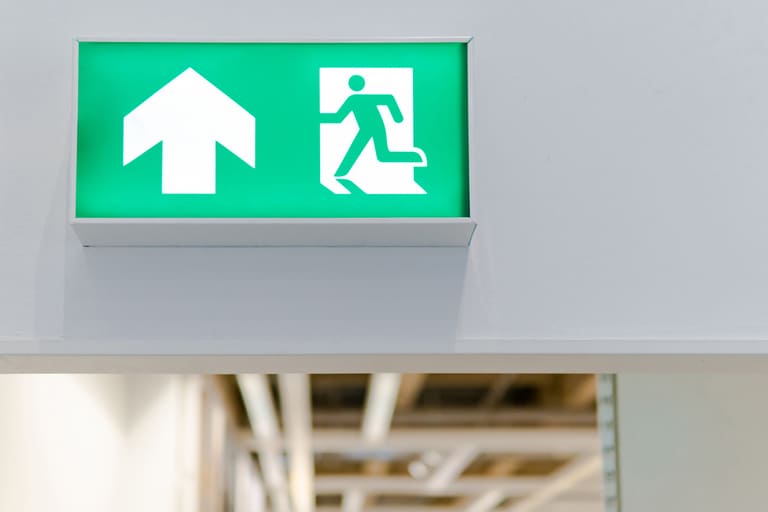
Tent warehouses must have the minimum firefighting equipment required by the Fire Service Law.
This is essential to ensure safety in the event of fire. In addition, to ensure a higher level of safety, other fire-fighting equipment should be considered for installation, depending on the size and use of the warehouse.
For example, automatic fire alarm systems that can detect fires at an early stage and sprinkler systems that can extinguish fires quickly.
Appropriate installation of these systems will minimize fire risks and ensure safe warehouse operations.
fire extinguishing equipment
Fire extinguishing equipment refers to equipment installed for the purpose of preventing, controlling, and extinguishing fires.
Typical examples include indoor and outdoor fire hydrants, sprinklers, steam fire extinguishing systems, and fire extinguishers.
Prompt use of these items in the event of a fire will enable appropriate initial response and prevent the spread of damage.
In particular, sprinklers and fire hydrants play an important role in controlling the spread of fire and preventing large-scale damage.
Alarm equipment
An important firefighting measure in tent warehouses is an alarm system.
This refers to all equipment for early detection and alarm of fires.
These include fire alarms and emergency broadcasting equipment, which provide immediate notification in the event of a fire.
In addition, automatic fire alarms, gas leak alarms, and electric leak fire alarms are also important.
They not only notify people inside the building of an emergency, but also quickly alert the fire department.
In recent years, systems that detect environmental changes in the air and predict fire risks have been introduced to prevent electrical fires and other potential hazards.
evacuation facilities
Evacuation equipment is an important device used to ensure safe evacuation in the event of a fire.
Specifically, emergency lighting, guide lights, and evacuation ladders will be installed.
Especially in buildings with two or more floors, Escape Chute and Evacuation Slide are also applicable for quick evacuation.
These facilities are essential to ensure safe evacuation in the event of fire and play an important role in saving lives.
Periodic inspections important for firefighting equipment
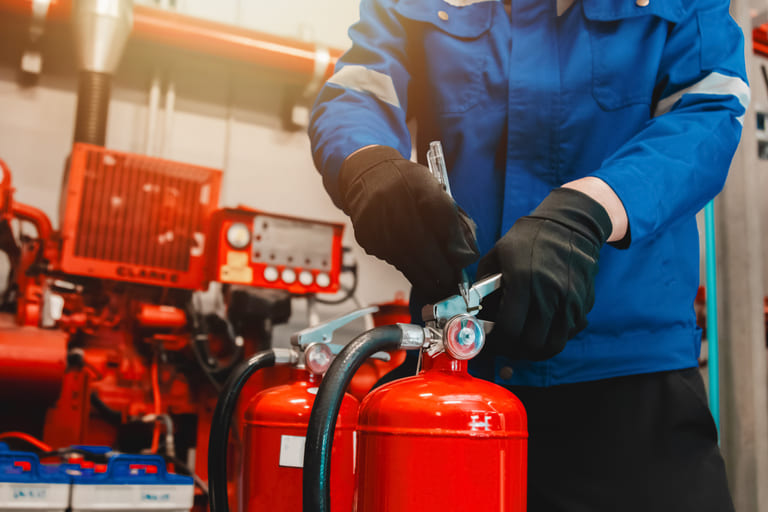
Firefighting equipment must operate reliably in the event of a fire or other emergency.
Therefore, periodic inspections and reporting are required by law.
There are two types of inspections: “equipment inspections” and “comprehensive inspections,” each with a different role.
Equipment Inspection” is an inspection to check the appearance and simple operation of equipment.
This is performed every six months and is essential to maintaining the basic condition of the facility.
Comprehensive inspections, on the other hand, are inspections that actually operate the equipment and check in detail whether the functions are working properly.
This one is required to be conducted once a year.
In principle, these inspections are to be performed by a certified firefighting engineer or a professional engineer with specialized qualifications.
In addition, a report of the results after the inspection is required to be submitted to the competent fire chief or fire station chief.
The reporting frequency is once a year for specified fire protection objects (commercial facilities, etc.) and once every three years for non-specified fire protection objects (warehouses, etc.).
Failure to report inspections is a violation of inspection and reporting obligations and may result in a fine of up to 300,000 yen or detention.
It is important to ensure regular inspections and proper reporting to avoid legal risks and ensure fire safety.
Tent Fabrics Important for Fire Fighting in Tent Warehouses

Fire prevention measures for tent warehouses require the installation of equipment in accordance with the Fire Service Law.
However, the selection of the tent fabric used is also important.
Tent fabrics must be either “noncombustible” or “flameproof”.
Understanding the characteristics of noncombustible and flameproof fabrics and choosing the appropriate one is essential to reducing fire risk.
We will first discuss each of these in detail.
nonflammable fabric
Noncombustible fabrics are noncombustible materials approved by the Minister of Land, Infrastructure, Transport and Tourism in accordance with the Building Standard Law, and have the characteristics of not burning for 20 minutes when exposed to fire and preventing deformation and cracking that would be harmful to fire protection.
An additional requirement is that no harmful smoke or gases be generated during evacuation.
The structure of this noncombustible fabric includes glass fibers in the PVC film, so that even if the surface burns, the fiber portion inside will not burn through.
This has the effect of preventing fire sparks from entering the building and spreading.
Noncombustible fabrics are composed of a resin surface skin and a glass base fabric, and are characterized by the fact that they do not penetrate fire and maintain a certain level of fire resistance.
However, the key to this material is not that it is “completely unburnable” but that it does not burn through.
On the other hand, noncombustible fabrics also have disadvantages.
For example, it is less flexible than flameproof fabrics and is more susceptible to folding and bending.
In addition, from a cost perspective, nonflammable fabrics are expensive and present a higher hurdle for their introduction compared to flameproof fabrics.
Nevertheless, for tent warehouses where fire performance is important, the use of noncombustible fabrics contributes to fire risk reduction and is an essential factor in improving safety.
Fireproof Fabric
Flameproof fabric is a fabric that is resistant to fire and does not spread easily even if ignited.
In addition, it has the property of self-extinguishing when removed from the flame, making it a highly safe fabric.
This is expected to reduce the speed of fire spread and prevent the spread of damage in the event of a fire.
Especially during the average of about 8 minutes before fire engines arrive, they not only help to protect lives and goods, but also play an important role in securing safe evacuation routes and buying time for initial firefighting.
Flameproof fabrics are not limited to tent warehouses, but are also widely used in applications such as rain shelters, sunshades, sheet curtains, and partition sheets.
This fabric will continue to burn as long as a fire source is present, but it has the property of self-extinguishing once the fire source is gone.
To be certified as flameproof, a product must meet the quality standards of the Japan Fire Retardant Association, and for fabrics for tent warehouses, it is required to pass a flameproof class 2 test based on the JIS A1322 standard.
This fire retardant performance reduces damage in the event of a fire, bringing peace of mind to the warehouse building and its users.
Construction Areas for Tent Warehouses
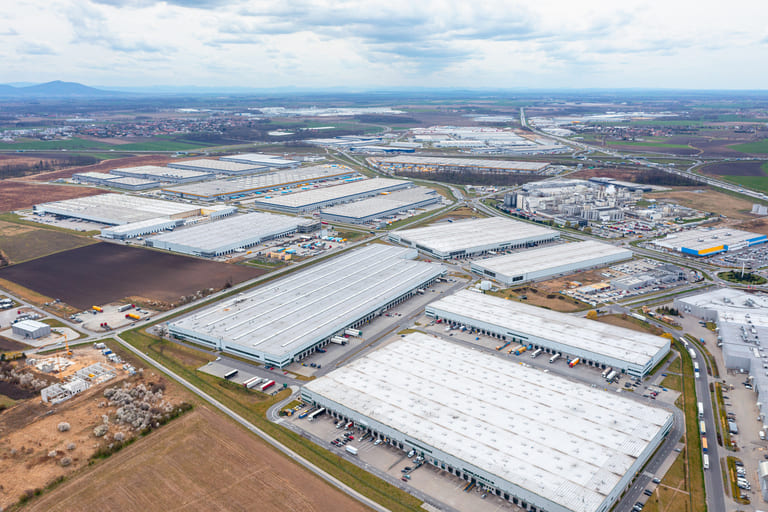
Suitable fabric materials for tent warehouses vary depending on the area of construction and the items to be stored.
This is because each specific area, such as fire zones, quasi-fire zones, and even Article 22 zones, have different regulations, and fire damage control is required accordingly.
Therefore, it is important to first confirm which area the proposed construction site belongs to.
Since each region requires appropriate measures, research in advance which regulated areas apply to the area where you plan to build your tent warehouse.
To conduct research, basic information can be easily obtained by searching for keywords such as “◯◯◯ city fire prevention district” or “semi-fire prevention district” on Google or Yahoo!
To obtain more accurate information, it is useful to visit the city planning section or building guidance section of the municipal office.
It is a good idea to bring a residential map with you so that you can clearly communicate the location to be surveyed.
After checking local regulations, selecting the appropriate construction materials is an important first step in the construction of a safe and secure tent warehouse.
fire protection area
Fire zones can be divided into two main types. One is when they are designated for commercial areas in urban centers where buildings are densely built and there is a lot of pedestrian traffic and pedestrian traffic.
In these areas, fire damage must be minimized.
The other type of area is designated along arterial roads where emergency vehicles pass, with the aim of preventing the spread of fire in the event of a disaster.
In these areas, wooden buildings are basically not allowed to be constructed in order to strengthen fire prevention measures.
quasi-fire prevention area
Semi-fire zones are designated for neighborhoods in fire zones, and regulations are in place to limit the spread of fire.
Therefore, certain standards are required for building construction.
For example, a building with 4 or more floors (excluding the basement) or a total floor area of more than 1500 m2 must be fireproof.
On the other hand, wooden houses can be constructed for buildings with three or fewer stories and a total floor area of 500 m2 or less, provided that the exterior walls and eaves are of fireproof construction.
This reduces the risk of fire in the area while also ensuring a certain degree of freedom in construction.
Act 22 zone
In addition to fire zones and quasi-fire zones, “Article 22 zones” are also subject to fire prevention regulations.
This is not stipulated under the City Planning Law, but under Article 22 of the Building Standards Law.
In this zone, building roofs must be constructed of noncombustible materials.
In addition, wooden buildings and other structures must use materials with high fire protection performance for exterior walls where there is a risk of fire spread.
Tent fabric requirements vary by region and storage materials
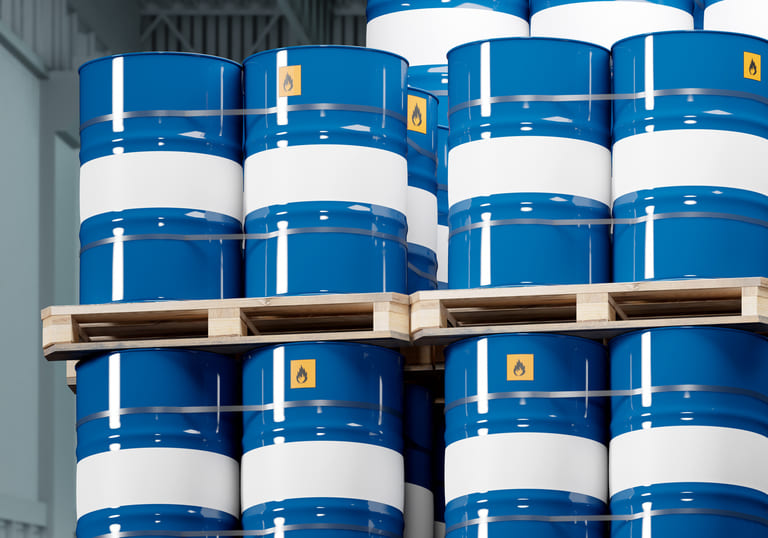
We have discussed the relationship between the fabric of the tent warehouse and the area in which it is constructed.
Finally, we will discuss the required fabric materials, which vary depending on the construction area and the nature of the stored materials.
Make sure you understand the requirements correctly and choose the best tent fabric.
When storing flammable materials
When storing combustible materials such as paper, plastic, and fabric products, it is important to choose the right tent fabric for the location and floor space.
Let’s take a look at the differences between regions.
In fire zones
In fire zones, the use of noncombustible fabrics is required regardless of floor area.
Even if the floor area is less than 100 m2, noncombustible fabric is required unless there is a risk of fire spread.
Furthermore, even if the floor area is 500 to 1,000 m2 or less, noncombustible fabrics are required to be used if there is no risk of fire spread.
In quasi-fire prevention areas
In semi-fire zones, the types of tent fabrics that can be used vary according to fire protection conditions.
It is especially important to select appropriate fabrics to ensure safety when storing flammable materials.
If the floor area is 500 m2 or less and there is no risk of fire spread, the roof must be made of noncombustible materials and the exterior walls must have fire-retardant fabrics.
On the other hand, in cases where the floor area is 500 to 1,000 m2 or less and there is no risk of fire spread, stricter standards apply, requiring the use of noncombustible materials for both the roof and exterior walls.
In the case of a zone under Article 22 of the Law
In the Article 22 zone of the law, if the floor area is 1,000 m2 or less and there is no risk of fire spread, the roof must be made of noncombustible materials and the exterior walls must be fire retardant.
However, if an inner curtain (flame retardant membrane) is used in conjunction with the roofing material, the roofing material is also permitted to be made of flame retardant material.
When storing noncombustible materials
Storage of noncombustible materials such as ceramics, magnets, glass, and metals follows common conditions with no regional differences.
Noncombustible fabrics must be used if the floor area is 1,000 m2 or less and there is “a risk” of fire spread.
On the other hand, if the floor area is 1,000 m2 or less and there is “no risk” of fire spread, flameproof fabrics must be used.
summary
It is essential that firefighting equipment for tent warehouses be properly installed and managed in accordance with the Fire Service Law.
Compliance with the installation standards for fire extinguishers and fire alarms appropriate to the size and use of the warehouse will ensure a quick response in the event of a fire.
In particular, proper understanding of the capacity units and placement standards for fire extinguishers and appropriate installation in consideration of walking distance limitations are required.
It is also important to maintain firefighting equipment to ensure that it is functioning properly by keeping up with regular inspections.
Furthermore, in the fire prevention of tent warehouses, the selection of the tent fabric to be used is directly related to the reduction of fire risk.
Safety can be enhanced by understanding the characteristics of noncombustible and fire-retardant fabrics and selecting the most appropriate material for the local regulations and warehouse application.
Additionally, checking the fire prevention regulations for each construction area in advance and taking appropriate firefighting measures are key to minimizing risk.
In addition to complying with fire codes, more advanced fire prevention measures can help prevent damage from fire and create a safe environment in which to operate your warehouse.
If you are considering the construction of a tent warehouse or have any other concerns, please contact Taiyo Kogyo Corporation, a manufacturer that has been in business for 100 years and has the largest market share in Japan. We will propose the best plan based on our technical capabilities and abundant experience backed up by our long track record.
Tent Warehouseへの
Contact us
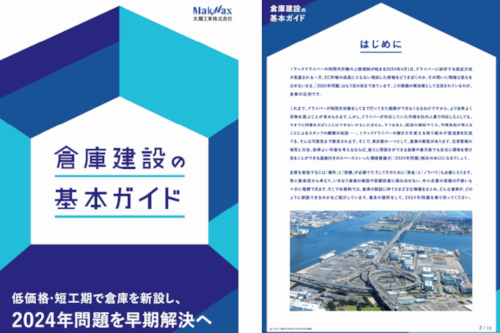
What you need to know when building a warehouse
We've packed it all in.
Clues to solving the 2024 problem
<
・Don't know where to start in building a warehouse
・Want to build a warehouse economically
・Want to know which type of warehouse to build
・Anyway, want to learn the basics of warehouse construction
・Worried about the 2024 problem, but don't know what to do
Related Articles
- TOP>
- Taiyo Kogyo Column>
- Thorough explanation of firefighting equipment for tent warehouses|From necessary equipment (fire extinguishers) to inspections and fabrics.







